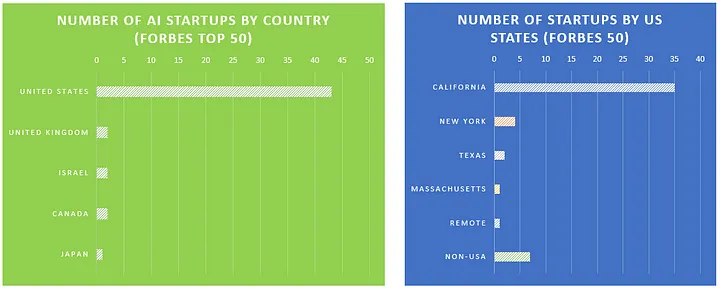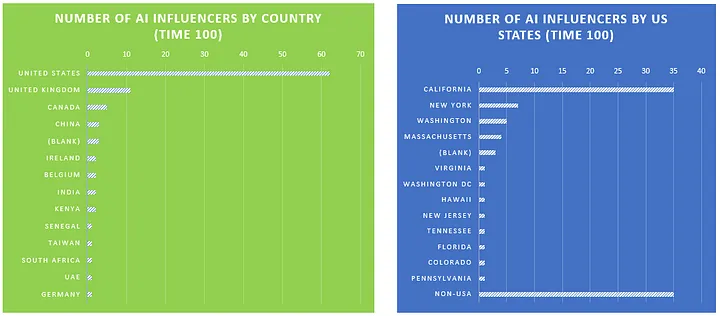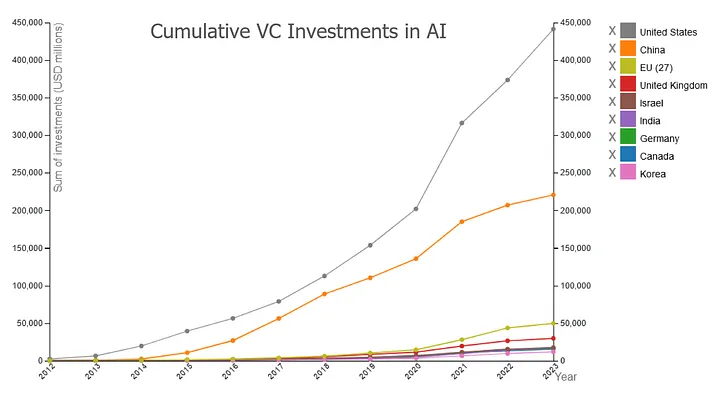A few weeks ago, Amazon’s announcement of a $4B investment in Anthropic, an AGI startup founded by ex-OpenAI employees with a sky-high valuation, caught my attention.
Just like OpenAI, the company is based in San Francisco. The City by the Bay has been yearning for love for some time, and there have been signs that AI could fuel a renaissance in San Francisco, leading to another tech boom in both the city and Silicon Valley. Dreamforce (“the World’s Largest AI Event” — no comment) made a significant comeback in San Francisco and was considered a success. My interactions with budding entrepreneurs returning to San Francisco and Silicon Valley to start or join the next AI startup reaffirmed the signs of a renaissance.
Motivated by this, I embarked on a journey to discover where the true epicenters of AI innovation lie. I sought to find the people, startups, VCs, and universities that are shaping the future of AI. After all, they might very well be shaping the future of our society!
Why do places matter? Epicenters of innovation cannot be virtual, especially after enduring years characterized by lockdowns, a precipitous migration to virtual interactions, and the distillation of human engagement to a realm defined by time zones, virtual meetings, and digital conferences. This transformative period underscored our appreciation for vibrant in-person communities — crucibles where intellects converge, ideas intermingle, and collaborative energies coalesce. These are not mere geographical points, but nurturing circles that empower individuals to delve into their pursuits in environments enriched and shaped by their own unique blends of cultural ethos, regulatory frameworks, historical legacies, and demographic diversities. In these fertile grounds for innovation, the location is more than a backdrop; it’s a silent catalyst, continuously molding and being reshaped by the minds it hosts.
My exploration was three-pronged, focusing on:
- Leading AI companies and influencers as identified by Forbes and Time.
- Venture capital sources and investments in the AI field.
- Universities recognized for AI education and research.
A Tale of Two Lists- Hot companies and Influential Leaders
In April this year, Forbes published the ‘Top 50 AI Companies,’ while in September, Time published the ‘Top 100 Most Influential AI Leaders.’ The two publications took distinct approaches.
Forbes is all business, listing the top 50 AI companies that matter for the fifth year, with help from VCs Sequoia and Meritech Capital, recognizing ‘the most promising privately-held companies building businesses out of artificial intelligence.’ The lucky 50 have received a collective $27B in funding. For the first time in five years, Forbes opened the list beyond North American companies, based on the nearly 800 submissions they received.
The Time 100 AI influencers are tech entrepreneurs, scientists, artists, politicians, regulators, advocates — a diverse group of people with the power to shape what might be the most influential technology of our lifetime. Time reviewed hundreds of nominations, whittled them down to 100, and interviewed almost all of the finalists to gain their perspectives on the path of AI today — organized into four categories: Innovators, Leaders, Shapers, and Thinkers.
So where are all these brilliant AI minds?
I was somewhat shocked by the Forbes 50 list. I had anticipated seeing more companies from outside California and Silicon Valley, and more from beyond the US, especially since this is the first year Forbes has included non-US companies. Yet, here we are: 86% of the Top 50 are based in the US, with 70% in California, and 66% in the San Francisco Bay Area. Outside the US, only one company is in Europe (UK), and shockingly, none are in France. Perhaps the articles heralding the rebirth of San Francisco and Silicon Valley are indeed right on the money.

Figure 1 — Location of Top AI Startups (Forbes 50)
Now what about the Time 100? In the Time list, entrepreneurs are a minority amongst scientists, artists, politicians, regulators, etc. Well, 64% are in the US, followed by 11% in the UK, and 5% in Canada. California represents 36% of the Top 100, head-to-head with all the non-US leaders in aggregate, followed by New York, Washington (Seattle) and Massachusetts (Boston). By the way, none of the 100 seem to live in France. Funny enough, the only Florida-based influencer I could track in any of the 2 lists is…. French: the CEO and Co-Founder of Hugging Face moved to Miami during the pandemic and seems to like it down there.

Figure 2 — Location top AI Influencers (Time 100)
Following the AI Money Trail
2023 has been tumultuous for venture capital, with AI securing a larger portion of a shrinking pie. The US remains the uncontested leader, expanding its lead over China, a distant second, while the EU lags significantly behind in third place.
According to Crunchbase, AI’s portion of US startup funding doubled in 2023 to 25% of American startup investments (compared to 12% in 2022). Meanwhile, North American startup funding fell by 50% to $31.8B in Q2 2023 (down from $64B in Q2 2022). Simple arithmetic indicates that VC investments in AI in the US have essentially remained static in 2023 compared to 2022 thus far. However, this trend likely won’t last, as OECD/Preqin predicts an increase by the end of 2023. In fact, OECD/Preqin forecasts that the US will be the only country to boost its VC investment in AI relative to 2022. Now, just imagine the possibilities if VC funding rebounds in 2024.

Figure 3 — Cumulative VC Investments in AI by Country (OECD/Preqin)
The estimates from OECD/Preqin show US VCs ramping up their investments in AI, reaching $68B in 2023, an increase of 18% from 2022. China remains a distant second with projected investments of $14B for 2023, down 39% from 2022, while the EU lags with an anticipated $6B in 2023, a sharp decline of 61% from 2022. For comparison, France’s figures are set at $2B for 2023, a decrease of 29% from 2022.

Figure 4 — Flow of VC Investments in AI in 2023 (OECD/Preqin)
Where is the money going? The flow of VC investment in 2023 illustrates the sources of the funds, the industries they’re targeting, and the countries where the recipient startups are based. Again, US-based startups are securing an even larger portion of the pie when considering the destinations of these investments. In industries such as Financial Services and Insurance, where VCs from Singapore and the UK are making significant commitments, the majority of the investments are benefiting US-based startups.
So, once again, the US is maintaining or increasing its lead, despite China’s rapid pace between 2016 and 2018 in an attempt to catch up with and surpass the US in AI VC investments.
Nurturing Tomorrow’s Innovators: Spotlight on Leading Universities
Finally, where are the future technical talents and leaders learning and creating the AI technology of the future? EduRank’s ranking is based on universities’ research performance in AI, using a graph of 1.8 billion citations received by 83.2 million academic papers from 5,521 universities worldwide. The organization calculates publication ratings and adjusts them based on release dates. The ranking does not distinguish between undergraduate and graduate programs and does not adjust for current majors offered — but it serves my purposes well.
So, what is the data telling us? Not surprisingly, the US dominates again, with 45% of the Top 100 Best Universities for AI. China holds a solid second place with 19%, well ahead of the rest of the pack: the UK with 7% and Canada with 5%. Sadly, France did not make the Top 100 list at all… in fact, the first French university ranks at #317 (Paris Sud/Saclay).

Figure 5 — Top 100 Universities in the World for AI (Edurank)
China’s strong second-place showing is not a surprise (with institutions like Tsinghua, Harbin, Shanghai Jiao Tong, Zhejiang, etc.), as the country is fiercely competing for global AI supremacy. A cornerstone of the Chinese strategy, aiming for global AI leadership by 2030, involves investing heavily in AI research and expanding AI-related curricula to meet the growing demand for AI talent.
Within the US, while California clearly leads as the number one state for universities in the field of AI (with institutions such as Stanford, UC Berkeley, UC Los Angeles, UC San Diego, etc.), the locations of top universities are much more distributed around the country. Pennsylvania takes second place (with Carnegie Mellon, the University of Pennsylvania, Pennsylvania State, etc.), and Massachusetts is third (with MIT, Harvard, Boston University, etc.).
Conclusion
The data paint a vivid picture. While the global AI landscape is diverse and ever-evolving, the United States, particularly San Francisco and Silicon Valley, remains a formidable force. The influx of venture capital, coupled with educational prowess, underscores its dominance. China, with its relentless drive, is emerging as a significant player, eager to claim the AI throne. Unfortunately, Europe seems to be lagging, prompting a need for introspection and strategic repositioning. As AI continues its march into the future, it will be fascinating to witness how regional dynamics shape its trajectory.
AI systems are becoming increasingly intertwined with our daily lives and societies. The development of AI should reflect the diversity of human experiences and span cultural, ethical, and experiential dimensions. Excessive control and dominance by one region could be detrimental, hindering the avoidance of biases, fair representation, economic inclusivity, fostering trust, and adoption.
Article originally published on Medium
